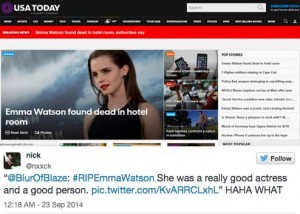By DIYA VASUDEVAN
Buzzfeed, a name I am sure you have heard of before, is a name I see everyday. As a journalism student I have always aimed of writing in a way that is both entertaining and informative and I feel that Buzzfeed encompasses just that.
If you have not heard of Buzzfeed, it is essentially an American Internet news media company, created and founded by CEO and co-founder Jonah Perreti. Although Buzzfeed originally seems just entertainment oriented, at the root of it, it is an extremely multi-faceted Website where you can either take fun quizzes like ‘Which “Which ‘SNL’ Icon Are You?,” look up articles based entirely on cats “17 Extremely Helpful Cats” alongside articles about ISIS “U.S. Condemns ‘Despicable’ And ‘Cowardly’ ISIS Beheading Of Egyptian Christians In Libya.”
What makes Buzzfeed so buzz worthy is that it is one of a kind, audiences can interact with the website by clicking buttons like “OMG” or “LOL” depending on the article. In addition comments by viewers are taken seriously and Buzzfeed take the extra step to acknowledge the readers for noticing these errors.
Recently, Buzzfeed uploaded a video involving President Obama “Things Everybody Does But Doesn’t Talk About, Featuring President Obama.” Buzzfeed managed to not only provide an entertaining video featuring the most powerful man in America but editors also managed to inform the public about ObamaCare.
In an age where media are merging, so are the aims of articles. In today’s world, you do not need to choose between CNN and ENews. Buzzfeed is a one-stop shop to newsworthy stories whether its entertainment or serious news. It is all about latest the buzz.

![image[2]](http://students.com.miami.edu/reporting/wp-content/uploads/2014/10/image2-300x187.jpg)


